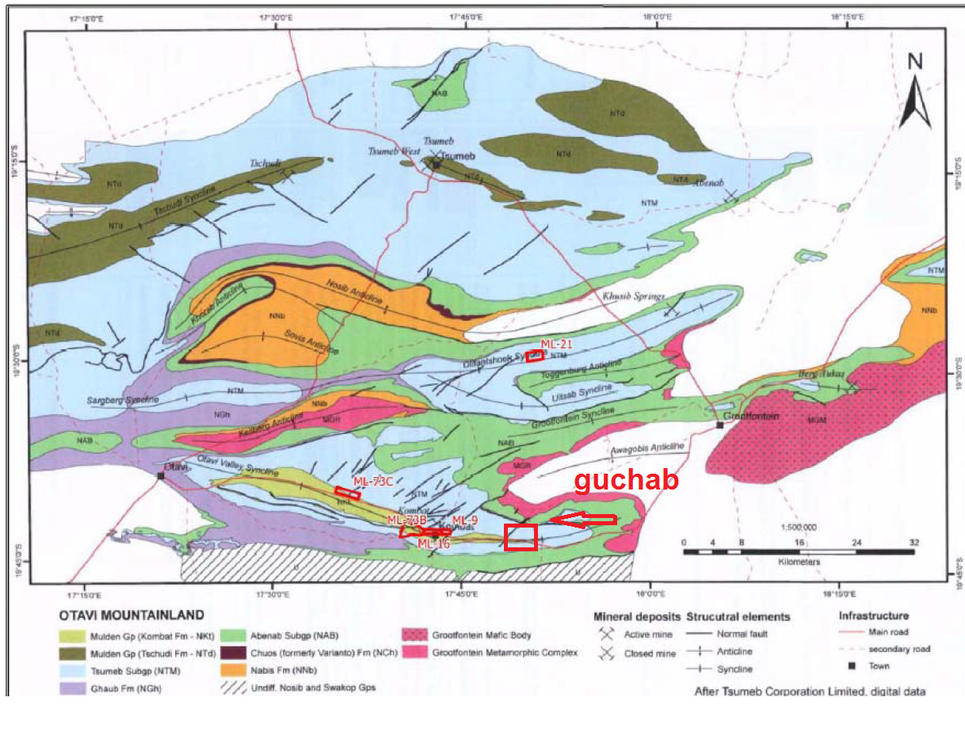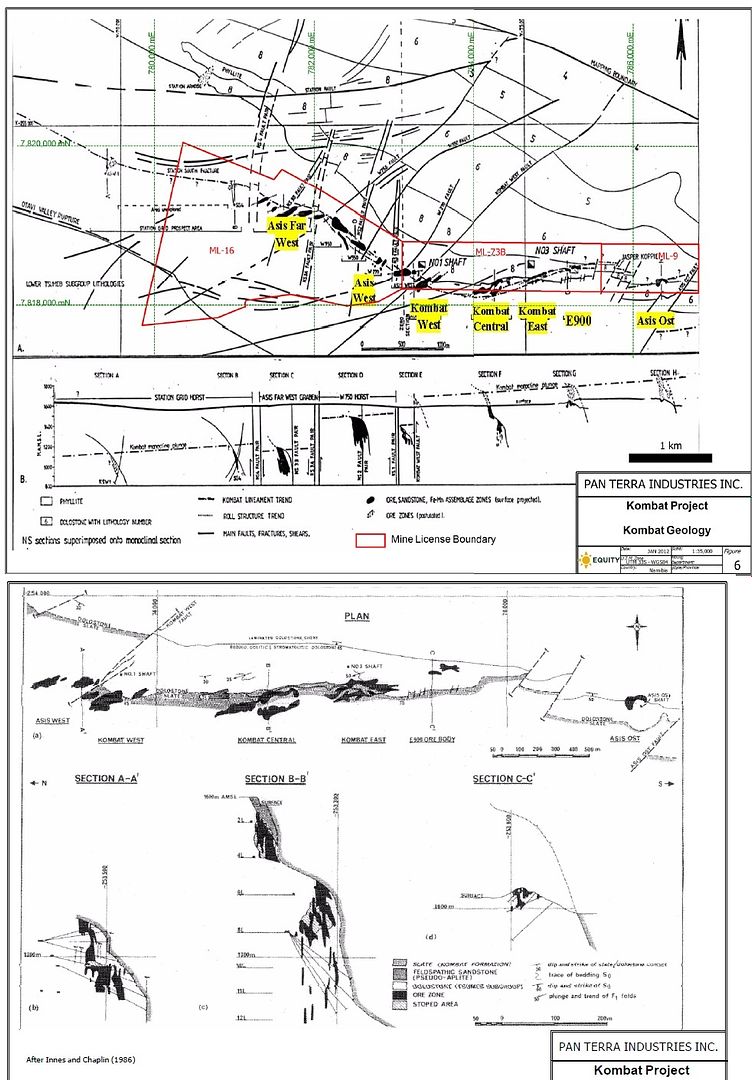the faulting is evident in the maps he used in his study
Local Geology
In the Otavi Mountainland (Figure 5), the Nabis Formation, the lowest formation of the Nosib Group, consists of basal conglomerate and arkosic quartzite grading upward to shale and phyllite; this represents a transition from fluvial to shallow marine sedimentation. It is unconformably overlain by Chuos (Varianto)Formation diamictite, grit and iron formation, which itself is overlain by shallow-water dolostones of the Berg Aukas and Gauss formations (Changara, 2009).
The Otavi Group consists of two subgroups. The lower Abenab Subgroup comprises massive and bedded limestone and dolostone. The Ghaub Formation, which forms the base of the Tsumeb Subgroup, is composed of glaciogenic diamictite and dropstone. Overlying the Ghaub Formation, the widespread
Maieberg Formation is characterized by thinly bedded limestone overlain by dolostone. The Elandshoek Formation (~1000m thick) conformably overlies the Maieberg Formation and consists principally of three dolostone units recognized throughout the Otavi Mountainland: a lower massive grainstone, a middle dolostone unit with oolitic and stromatolitic chert interbeds and an upper unit with repetitive minor cycles of dolomitic mudstone capped by boundstone. Chert-rich dolostone of the Hiittenberg Formation caps the Tsumeb Subgroup.
The uppermost group of the Damara sequence, the ll/Iulden Group, was deposited syntectonically with the D1 and possibly D2 deformation. It exceeds 2000 metres in thickness and consists of a lower Tschudi Formation and upper Kombat Formation. The Tschudi Formation comprises a basal conglomerate and a fining-upward feldspathic arenite with minor greywacke and intraformational breccias. The Kombat Formation is a slate, locally intercalated with greywacke. lt is more than 500 metres thick and occurs mainly in the Otavi Valley in the Kombat area, where it directly overlies Htittenberg Formation dolostone.
Local Geology
D1 deformation produced karsting in the Otavi Group dolostone and created the basins in which the Mullen Group was deposited. D2 deformation produced a number of generally east-west trending synclines and anticlines (Figure 5). The southernmost of these, the Otavi valley syncline, trends easterly for approximately 70 kilometres from the town of Otavi. It is a tight syncline cored by Kombat Formation phyllite overlying Hiittenberg Formation dolostone; its southern limb is overturned and northerly-directed thrust faults have been inferred in its core. The Otavi valley syncline is canoe-shaped due to warping during D3 deformation.
- Forums
- ASX - By Stock
- SBR
- chart
chart, page-107
-
- There are more pages in this discussion • 27 more messages in this thread...
You’re viewing a single post only. To view the entire thread just sign in or Join Now (FREE)
Featured News
Add SBR (ASX) to my watchlist
 (20min delay) (20min delay)
|
|||||
|
Last
1.4¢ |
Change
-0.002(12.5%) |
Mkt cap ! $5.501M | |||
| Open | High | Low | Value | Volume |
| 1.5¢ | 1.5¢ | 1.2¢ | $13.37K | 1.011M |
Buyers (Bids)
| No. | Vol. | Price($) |
|---|---|---|
| 2 | 313125 | 1.4¢ |
Sellers (Offers)
| Price($) | Vol. | No. |
|---|---|---|
| 1.5¢ | 60000 | 1 |
View Market Depth
| No. | Vol. | Price($) |
|---|---|---|
| 2 | 313125 | 0.014 |
| 3 | 225000 | 0.013 |
| 1 | 661499 | 0.012 |
| 2 | 327818 | 0.011 |
| 2 | 150000 | 0.010 |
| Price($) | Vol. | No. |
|---|---|---|
| 0.015 | 60000 | 1 |
| 0.016 | 79999 | 3 |
| 0.017 | 54500 | 2 |
| 0.018 | 187001 | 1 |
| 0.020 | 20000 | 1 |
| Last trade - 14.41pm 16/07/2024 (20 minute delay) ? |
Featured News
| SBR (ASX) Chart |






